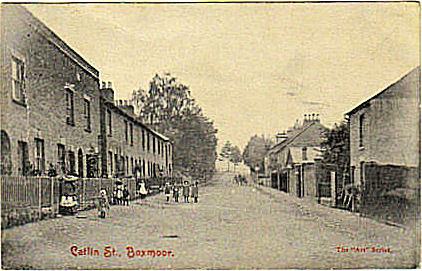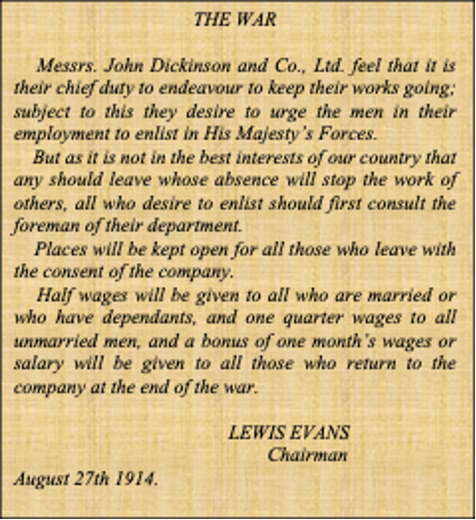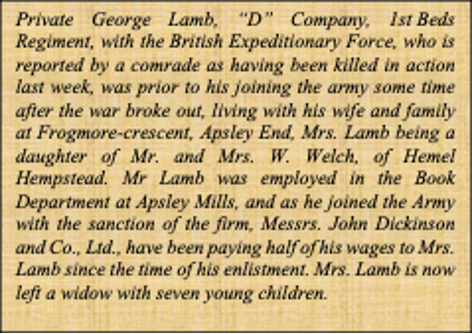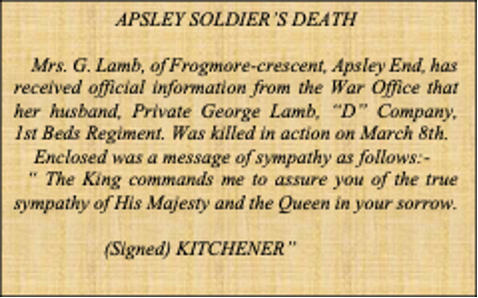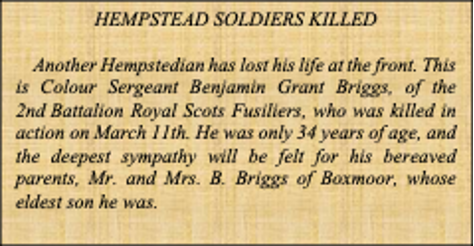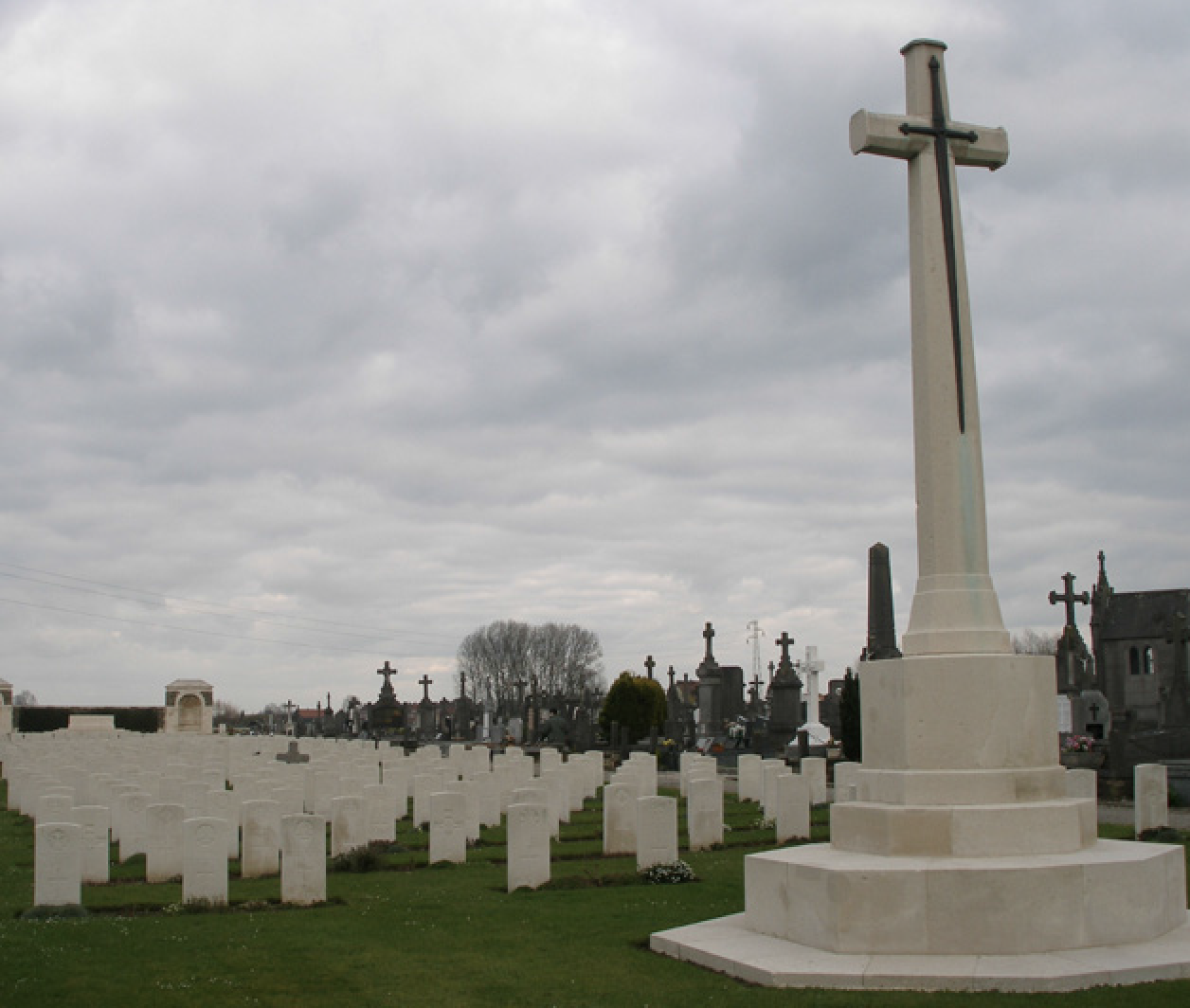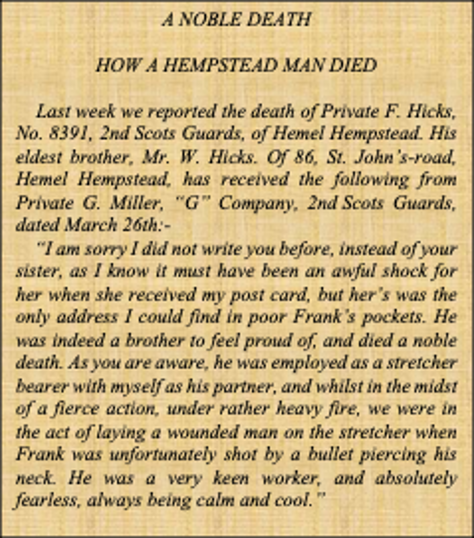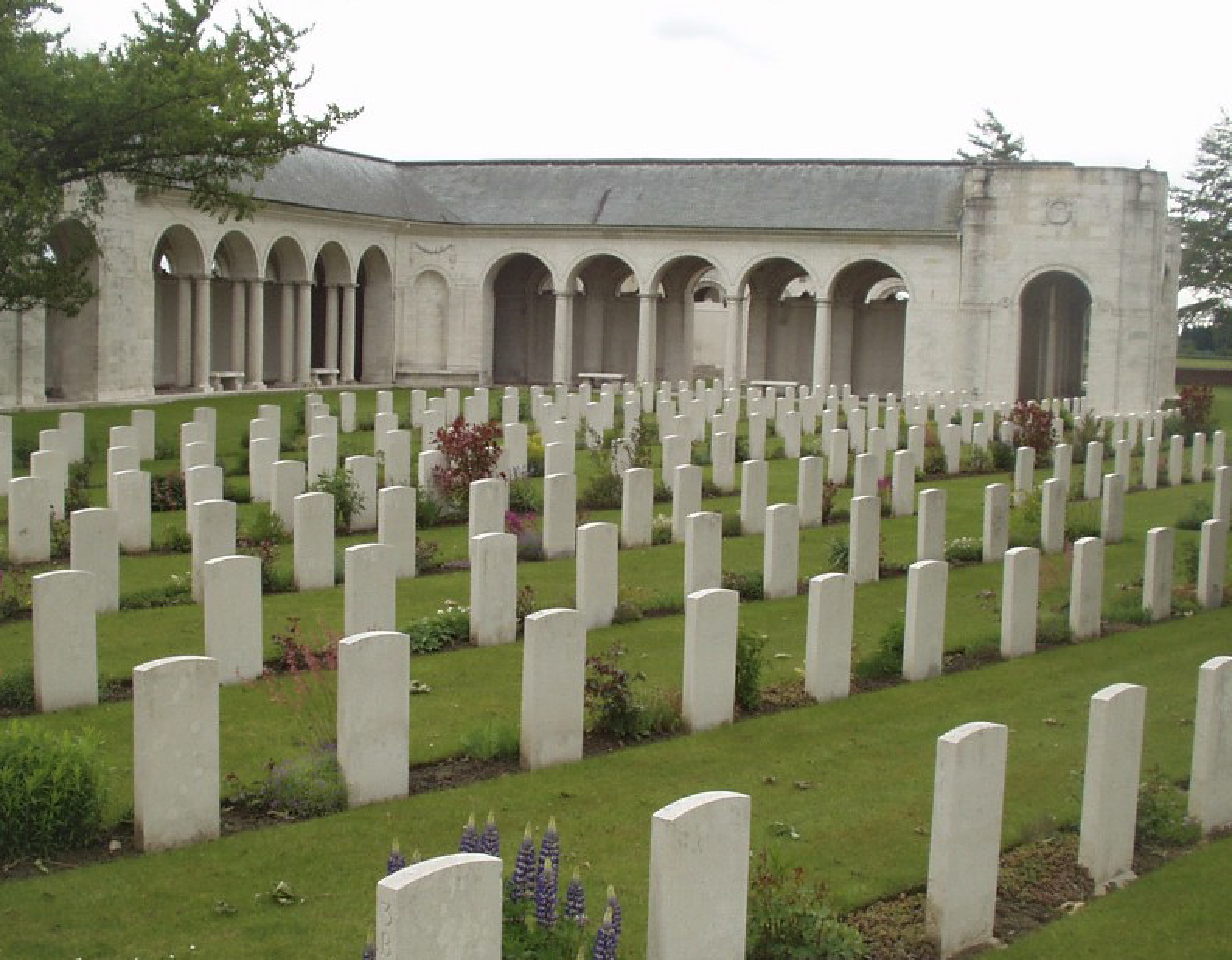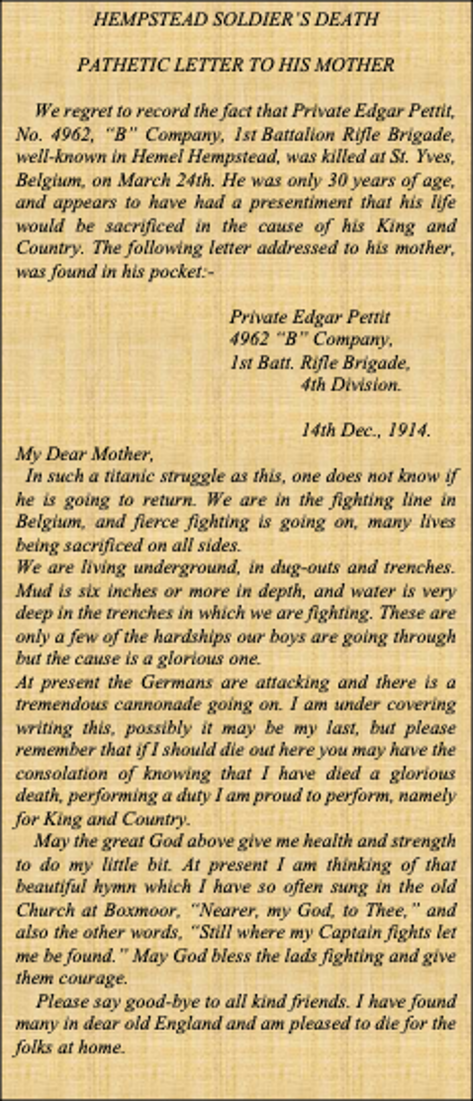Fallen in March 1915:
George Lamb
Benjamin Grant Briggs
Frank Hicks
Edgar Pettitt
GEORGE LAMB
13818 Private
1st Bn., Bedfordshire Regiment
Killed in Action Monday, 8th March 1915
Remembered with Honour, Ypres (Menin Gate) Memorial, West Vlaanderen, Belgium, Panel 31 and 33
George Lamb was born in Wendover,
Buckinghamshire in September 1877 the third son of Henry (Harry) and Annie. He
had six siblings in all, four brothers; Henry, John, Charles and Bertie and two
sisters; Florence (Florrie) and Ellen (Nellie). When George was born the family
were living on the Aylesbury Road in Wendover close to the Grand Union Canal
where Harry his father worked as a boatman. By 1891 they had moved to 5 Catlin
Street, Boxmoor, Hemel Hempstead and George was working as a domestic House Boy.
His future wife Sarah Elizabeth Welch was already working as a paper mill hand
at the age of 15 and they would meet shortly when George started work at John
Dickinsons in the Book Department.
George and Sarah were married on 3rd January 1897 at St Paul’s Church, Hemel Hempstead. They started married life at 65 Queen Street a few doors away from the Hall family at number 68, whose son William was killed only a month before George. Over the next thirteen years they moved four times, but never more than a few hundred yards from Queen Street, to 9 Union Square, 4 Armstrong Place, 7a Chapel Street and 18 Austin’s Yard. Their last move was to 7 Frogmore Crescent, Apsley and a cottage built by John Dickinson and Co for the use of employees of the company. During this time George and Sarah had seven children; George Victor, Nellie, Charles Edward, William, Albert, John and Bernard.
George was employed as a card edge
gilder at Dickinsons, a skilled job in a specialist aspect of the paper making
industry. Working at John Dickinsons when he volunteered for service meant that
George and Sarah benefited from the benevolence of the company. Dickinsons,
like many other companies at the outbreak of war, not only promised to hold
jobs open for volunteers, but also paid half wages to married men and offered a
month’s wages as a bonus to all men who returned from the conflict. (see extract)
George attested at Hemel Hempstead between the 29th August and 1st September 1914 during the first great surge in recruiting. After a relatively slow start, there was a sudden rush to join in late August and early September 1914. In all, 478,893 men joined the army between the 4th August and 12th September, including 33,204 on the 3rd September alone – the highest daily total of the war and more than the average annual intake in the years immediately before 1914.
Enlisting with the 1st Battalion Bedfordshire Regiment at Hertford and following initial training, George arrived in Belgium on 3rd December 1914 and was soon in the trenches. By 3rd March the Battalion was at Ouderdom 5 miles south west of Ypres. The Battalion war diaries record that sniping and shelling were considerable over the next few days:
‘6 Mar 1915 - canal bank south of Ieper Battn took over sector of trenches North of Canal, relieving 9th Brigade 1/Cheshire Regt. took over section S. of Canal. K.O.Y.L.I. on our left. Casualties in going up to trenches 3 wounded.
7 Mar 1915 Head Quarters shelled, 1 man killed. Sniping very considerable, total casualties 3 killed 1 wounded.
8 Mar 1915 A certain amount of shelling & sniping during day. Battn. relieved by Dorset Regt. at night & returned to support. Casualties Capt Andrews wounded: 2 killed & 9 others wounded.’
George was one of the two men killed recorded in the diary extract from 8th March 1915.
Reports appeared in the Hemel Gazette
about George’s death including a brief obituary and the telegram from the War
Office notifying his widow Sarah. (see extracts)
George is Remembered with Honour on
the Menin Gate Memorial at Ypres, West Vlaanderen, Belgium on memorial panel 31 and 33
George is also commemorated on Dickinsons Memorial in Apsley as is his son John (Jack). Jack worked in Dickinsons in the Book Binding department and he was killed in France during the Second World War, fighting with 21 Anti-Tank Regiment, Royal Artillery.
George was 38 years old when he was killed. He was eligible for the 1914-15 Star, the British War Medal and the Allied Victory Medal
Catlin Street, Boxmoor 1905 (Publc Domain)
Extract from the Hertfordshire, Hemel Hempstead Gazette and West Herts Advertiser, 5th Sep. 1914
Extract from the Hertfordshire, Hemel Hempstead Gazette and West Herts Advertiser 20th Mar. 1915
Extract from the Hertfordshire, Hemel Hempstead Gazette and West Herts Advertiser 3rd Apr. 1915
Ypres (Menin Gate) Memorial, Belgium (Courtesy: CWGC)
BENJAMIN GRANT BRIGGS
5518 Company Quartermaster Serjeant
2nd Bn., Royal Scots Fusiliers
Died of Wounds Friday, 12th March 1915
Remembered with Honour, Estaires Communal Cemetery and Extension, Nord, France, Plot III.A.1.
Benjamin Grant Briggs, known as Ben, was the older son of Benjamin Briggs and Gertrude Mary Clark. He was born in 1880 in Calcethorpe near Louth in Lincolnshire in a rural agricultural community. His father Benjamin came from a farming family and at the time of Ben’s birth he was working as an Auctioneer and Valuer, possibly in the farming industry.
Ben had six siblings two of whom died young. The surviving children were; Caroline Mary, Gertrude Amy who were older, then Helen Beecham and his younger brother Harry. By 1891 the family had moved south to Peterborough before coming to Boxmoor in 1892 where his father came to work, firstly as a Company Secretary for the Lim Mat Company and later, as an accountant with a firm of auctioneers. Initially they lived at 16 Horsecroft Road before moving to number 43 in 1906.
Ben attended Leverstock Green School after the family’s arrival in Hemel Hempstead although it is not apparent why he did so given that he lived in Boxmoor. However, he was a pupil at the school from 6th October 1891 until 14th November 1893 when he left at the age of thirteen.
Sometime after this date he enlisted
with the Royal Scots Fusiliers in London and went to South Africa with 2nd Battalion to fight in the Boer War between 1899 and 1902. He saw action at The
Battle of Tugela Heights between 14th and 27th February
1900, the last decisive engagement during The Relief of Ladysmith.
Ben held the rank of Colour Serjeant which changed in 1913 to Quarter Master Serjeant. This meant he was a non-commissioned officer in charge of supplies and who also served as the deputy to the company sergeant major and it was the second most senior NCO in the company.
He embarked for Belgium with the 2nd Battalion landing at Zeebrugge as part of the 21st Brigade in the 7th Division in October 1914 for service on the Western Front. The Battalion saw action at the First Battle of Ypres in October 1914, the Battle of Neuve Chapelle in March 1915, the Battle of Loos in October 1915, the Battle of the Somme in Summer 1916, the Battle of Arras in April 1917 and the Battle of Lys in April 1918.
It was during the Battle of Neuve Chappelle between the 10th and 13th March 1915 that Ben was killed. He was one of over 11,000 Commonwealth casualties in a battle which saw the award of ten Victoria Crosses. Ben died on 12th March from wounds received the previous day.
His death was reported in the Hemel
Gazette in March 1915. (see extract)
Ben was 34 years old when he was killed.
He is Remembered with Honour at Estaires Communal Cemetery and Extension, Nord, France, where he is interred in Plot III.A.1.
Ben was also commemorated on a memorial plaque, dedicated in 1920 in Leverstock Green School, along with twenty old boys who had fallen in the Great War. He is not included on the village war memorial and this is possibly explained by the fact that he was not resident in the village.
He was eligible for the 1914-15 Star, the British War Medal and the Allied Victory Medal.
Royal Scots Fusiliers Cap Badge World War 1
Extract from the Hemel Hempstead Gazette and West Herts Advertiser 20th Mar. 1915
Estaires Communal Cemetery and Extension, Nord, France (Courtesy: CWGC)
FRANK HICKS
8391 Private
2nd Bn., Scots Guards
Killed in Action Friday, 12th March 1915
Remembered with Honour, Le Touret Memorial, Pas de Calais, France, Panel 3 and 4
Frank Hicks was born in Hemel Hempstead on 10th February 1894 to Henry and Eliza Matilda and was baptized at St Mary’s Church on 9th March in the same year. The family lived at 3 Bailey’s Place near to where Bank Court is situated on Marlowes today. Frank’s father Henry died in 1899 aged 41 and his mother Eliza remarried in 1902. His step-father Albert Blackmore was a Moulder working in the Boxmoor Ironworks who was a widower also marrying for the second time.
Frank had eight siblings in all; William Henry, Percy, Mabel, Ethel, Harold, Dorothy, Ellen Eunice his step-sister and Ronald his half-brother. By 1911 the four youngest children, including Frank, where living with their parents at 105 Marlowes and seventeen-year-old Frank was working as a Millhand at John Dickinsons. Mabel, Ethel and Ellen were also employed by Dickinsons.
Henry Hicks, Frank’s father, had been a regular soldier for ten years between 1874 and 1884 with the Bedfordshire Regiment and he re-enlisted with the 4th Bn. Bedfordshire Regiment, a militia battalion, in 1888. Men would volunteer for the militia and undertake basic training for several months at an army depot. Thereafter, they would return to civilian life, but report for regular periods of military training (usually on the weapons ranges) and an annual two-week training camp. The militia appealed to agricultural labourers, colliers and the like, men in casual occupations, who could leave their civilian job and pick it up again. It is likely therefore that Henry re-enlisted to benefit from military pay and a financial retainer, a useful addition to his civilian wage as a general labourer. He remained with the militia until his death on 15th May 1899.
It may have been due to his father’s military service that Frank felt inclined to enlist and he did so on 31st August 1912, joining the Scots Guards in London when he was 18 years and 5 months old.
At the outbreak of war, the 2nd Battalion left the Tower of London with orders to assemble at Lyndhurst Camp in the New Forest. Sailing on 6th October 1914, the Battalion disembarked at Zeebrugge on the 7th as part of the 20th Brigade 7th Division and was soon engaged in action against the enemy at the First Battle of Ypres.
This is the battle that most marked
out the Scots Guards. The deaths recorded in the four weeks from 18th October, including those who died of wounds later or as prisoners of war having
been captured at Ypres, exceeded the total number of Scots Guardsmen who died
in each of the years 1917 and 1918. The 2nd Battalion lost four out
of five men.
Frank spent his 21st birthday in the trenches on 10th February 1915.
At the Battle of Neuve-Chapelle between the 10th and 13th March 1915, the 2nd Battalion Scots Guards War Diaries record details of operations:
On 12th March at 4.15am the Battalion moved off along the Nueve-Chapelle – Fauquissart Road to a point in a captured communication trench and from there proceeded to advance to a position 300 yards from enemy lines where the assault halted as they made plans for a further attack.
‘A
message from the Brigade postponing the attack until 12.30 PM was not received
owing to the orderlies who carried it being Killed and the attack was launched
at 10.30 AM’
Extract from the Hertfordshire, Hemel Hempstead Gazette and West Herts Advertiser, 3rd Apr. 1915
Le Touret Cemetery, Pas De Calais, France (Courtesy: CWGC)
The attack proceeded over difficult terrain for about 150 yards when it ‘was compelled to stop by a very heavy machine gun and rifle fire. Three officers and about 100 men where lost during this advance’
In all six officers and 192 NCOs and other ranks were lost over two days.
Frank Hicks was killed in action on Friday, 12th March 1915 when he was acting as a stretcher bearer and rescuing a wounded man amidst fierce fighting and heavy enemy fire.
The Hemel Gazette published a report of Frank’s death under the headline ‘A Noble Death’ on 27th March 1915. Frank’s colleague Private G. Miller wrote to Frank’s oldest brother William. In it he apologises for initially writing to Frank’s sister with news of his death and then goes on to describe the circumstances under which Frank was killed. (see extract)
One of Frank’s older brothers Harold also served in France as Bandsman in the 1st Suffolk Regiment and he was wounded twice but survived the War.
His ‘Register of Effects’ records that along with his mother Eliza, Frank had bequeathed his army pay to be divided equally amongst his siblings. They each received 16s 7d.
Frank is Remembered with Honour at Le Touret Memorial, Pas de Calais, France on Panel 3 and 4.
Frank was 21 years old when he was killed.
He was eligible for the 1914-15 Star, the British War Medal and the Allied Victory Medal.
EDGAR PETTITT
S/4962 Rifleman
1st Bn., Rifle Brigade
Died of Wounds Tuesday, 23rd March 1915
Remembered with Honour, Strand Military Cemetery, Hainaut, Belgium, Plot: VIII. R. 3.
Edgar Pettitt was born on the 6th December 1883 in Boxmoor to Arthur and Martha Ann. He was the middle child and he had an older brother Sidney Arthur and a younger sister Ethel May. His father was a Cellar Foreman at a Wine Merchants and the family lived at 28 Cotterells Road, Boxmoor where Arthur and Martha spent their entire married life. Both Edgar and Sidney worked for John Dickinsons and were listed as ‘Clerks in a Paper Mill’ on the 1901 Census.
Interestingly his sister Ethel May is listed as a ‘School Teacher’ on the same return when she is only fourteen years old. Further research revealed that she was in fact a ‘Monitor’ at Boxmoor Junior, Middle and Infant School. Teaching duties in Victorian schools were sometimes passed on to some of the brightest children and they were known as ‘Monitors’. They would be taught by the Headmaster and would then pass this onto small groups of children as another way of educating.
It seems all three of the Pettitt children were ‘bright’ enough to complete their education successfully and acquire jobs with promising prospects.
Edgar’s schooling also took place at Boxmoor JMI starting on 17th June 1889. The daily school log records that on 6th October 1894 he was absent from school with Diphtheria and a few of his classmates were also absent with a variety of ailments. Of greater concern to the teacher however, was the absence of many other boys for what seems a rather spurious reason; ‘over 20 boys are absent this afternoon “acorning”. St IV (Standard IV Class) do not attend well and are an awful drag.’ Elsewhere the same teacher laments absences for “blackberrying” and parents keeping children away from school to work illegally. All an indication of the need for poorer families to earn money in any way possible.
There were six Standards of Education given in the Revised code of Regulations, 1872 in Victorian schools. These standards do not correspond to year groups as promotion was on merit, and many children did not complete all the grades. Standard IV, mentioned in the School Log, had three elements: Reading - Read a few lines of poetry or prose, at the choice of the inspector; Writing - Write a sentence slowly dictated once, by a few words at a time, from a reading book, such as is used in the first class of the school and finally; Arithmetic - Compound rules (common weights and measures). Edgar completed all six standards successfully by the time he left school in April 1897 when he joined Dickinsons as a Clerk.
He seems to have left his job with Dickinsons by the time war broke out as he is not listed on the Company war memorial at Apsley. He volunteered in August 1914 and enlisted with the 1st Bn. Rifle Brigade and following initial training he was drafted to the Front on the 23rd November of the same year.
The 1st Battalion had landed at Le Havre in France as part of the 11th Brigade in the 4th Division in August 1914 and it saw action at the First Battles of the Marne and the Aisne in September and the Battle of Messines in October. The Battalion war diaries then record continuing movement until reaching Ploegsteert Wood eight miles south of Ypres. In fact, it moved a total of 344 miles between the 25th August and the 21st November, often only a few miles each day but, in early October the Battalion covered sixty-two miles in four days.
By 18th March 1915, Edgar was with the Battalion at St Yves just north of Armentières and the diaries record that the men’s absence from the trenches was causing some concern; ‘18th March Men have got out of the way of trench life and are apt to expose their heads needlessly’
On the 19th March orders were received that the battalion was to relieve the St Yves position from the Royal Dublin Fusiliers and over the next three days it was to experience ‘some shelling and sniping and a good many rifle grenades fired by the Germans’
Casualties are not recorded for the month but it was on 24th March 1915 that Edgar died of wounds received either on that day or in the preceding few days.
Edgar, like many other soldiers at
the time, had written a letter to be passed on in the event of their death. His
was to his mother and touchingly speaks to his faith and his pride in doing his
duty. It was published in the Hemel Gazette a few weeks after he was killed. (see extract)
Edgar is Remembered with Honour at Strand Military Cemetery, Hainaut, Belgium and he is interred there in Plot: VIII. R. 3. The inscription on his headstone, requested by his mother Martha reads: HE DIED FOR HIS COUNTRY NOW ASLEEP IN CHRIST
Edgar was 30 years old when he was killed. He was eligible for the 1914-15 Star, the British War Medal and the Allied Victory Medal.
Boxmoor Junior, Middle and Infant School, © Peter Wagon Fine Arts, www.peterwagonfinearts.co.uk
Extract from the Hertfordshire, Hemel Hempstead Gazette and West Herts Advertiser, 10th April 1915
Strand Military Cemetery, Hainaut, Belgium (Courtesy: CWGC)
